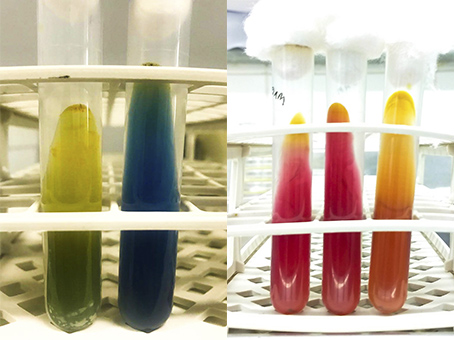Isolation of bacteria present in the veterinary necropsy room and health risks
Aislamiento de bacterias presentes en la sala de necropsias veterinarias y riesgos para la salud


This work is licensed under a Creative Commons Attribution-NonCommercial-ShareAlike 4.0 International License.
Show authors biography
Objective. The aim of this study was to characterize the bacteria of a veterinary autopsy room, their antimicrobial susceptibility profile and testing the efficiency of two sanitizers against these microorganisms. Materials and methods. Three points of the room that professionals do not normally wear personal protective equipment (PPE) getting in direct contact with these bacterias. Anaerobic and aerobic mesophilic count were performed before and after disinfection with hypochlorite and sodium alkylbenzene sulfonate then, isolates were identified by their morphotintorials and biochemical characteristics and their antibiotic susceptibility. Results. Preliminary results indicated that the hypochlorite was the sanitizing agent of choice for surface disinfection and against the most frequent potential pathogenic bacterials isolated such as Staphylococcus spp (75%), E. coli and Klebsiella spp (15%), and Pseudomonas spp (10%). In addition, 25% of the staphylococci were resistant to at least one antimicrobial tested and Klebsiella spp, E. coli, and Pseudomonas spp were taken into consideration, wide antimicrobial resistance tested were observed. Conclusions. The characterization of these bacteria found in the autopsy room is important to alert professionals about the biological risks they are exposed to, as well as the precautions they should take.
Article visits 1125 | PDF visits
Downloads
- Sharma BR, Reader MD. Autopsy room: a potential source of infection at work place in developing countries. Am J Infect Dis. 2005; 1(1):25-33. https://10.3844/ajidsp.2005.25.33
- Silva LM, Barbosa MG, Fernandes MB, Ribeiro RCF, Mizobutsi EH. Progresso temporal e controle da antracnose em banana no semiárido norte mineiro. Rev. Bras. Frutic. 2016; 38(1):81-91. https://doi.org/10.1590/0100-2945-299/14
- Sharma BR, Harish D, Gupta M, Singh VP, Vij K. Health hazard free mortuary–A formidable task for the Indian hospitals. Indian Internet J Forensic Med Toxicol. 2003; 1(3). http://www.indianjournals.com/ijor.aspx?target=ijor:iijfmt&volume=1&issue=3&article=002
- Tan X, Coureuil M, Charbit A, Jamet A. Multitasking Actors of Staphylococcus aureus Metabolism and Virulence. Trends Microbiol. 2020; 28(1):6-9. https://doi.org/10.1016/j.tim.2019.11.003
- Różańska A, Romaniszyn D, Chmielarczyk A, Bulanda M. Bacteria contamination of touch surfaces in Polish hospital wards. Medycyna Pracy. 2017; 68(4):459-467. https://doi.org/10.13075/mp.5893.00575
- Atlas RM. Handbook of microbiological media. London: CRC Press Inc., 2010. https://www.cabdirect.org/cabdirect/abstract/20123045333
- Cowan ST, Steel KJ. Manual for the identification of medical bacteria. London: Cambridge University Press. 1965. https://www.cabdirect.org/cabdirect/abstract/19652705468
- Koneman EW. Diagnóstico microbiológico: texto e atlas colorido. Guanabara koogan. 2012. https://www.amazon.com/-/es/Gary-W-Procop/dp/8527733188
- Patel JB, Weinstein MP, Eliopoulos GM, Jenkins SG, Lewis JS, Limbago B, et al. Performance standards for antimicrobial susceptibility testing – 27th edition. Clinical and Laboratory Standards Institute: Wayne, USA; 2017. https://clsi.org/media/1469/m100s27_sample.pdf
- Maujean G, Malicier D, Fanton L. Air, Water, and Surface Bacterial Contamination in a University Hospital Autopsy Room. J Forensic Sci. 2013; 57(2):381-385. http://dx.doi.org/10.1111/j.1556-4029.2012.02054.x
- Mokracka J, Koczura R, Kaznowski A. Multiresistant Enterobacteriaceae with class 1 and class 2 integrons in a municipal wastewater treatment plant. Water Res. 2012; 46(10):3353-3363. https://doi.org/10.1016/j.watres.2012.03.037
- da Silva FC, Antoniazzi MCC, Rosa LP, Jorge AOC. Estudo da contaminação microbiológica em equipamentos radiográficos. Revista Biociências. 2013; 9(2):35-43. http://periodicos.unitau.br/ojs/index.php/biociencias/article/view/111
- Prado-Palos MA, Costa MD, Gir E, Suzuki K, Pimenta FC. Atuação da enfermagem em Unidades de Terapia Intensiva: implicações para disseminação de microrganismos multirresistentes. Rev Panam Infectol. 2010; 12(1):37-42. http://repositorio.bc.ufg.br/tede/handle/tde/718
- Both, JMC, Longaray, SM, Avancini CAM. O desinfetante hipoclorito de sódio como barreira sanitária: condições de atividade frente a Staphylococcus aureus isolados em alimentos envolvidos em surtos de toxinfecções alimentares. Rev Inst Adolfo Lutz. 2009; 68(2):254-258. http://periodicos.ses.sp.bvs.br/scielo.php?script=sci_arttext&pid=S0073-98552009000200012&lng=pt
- Weese JS, Duijkeren EV. Methicillin-resistant Staphylococcus aureus and Staphylococcus pseudintermedius in veterinary medicine. Vet Microbiol. 2010; 140(3-4):418-429. https://doi.org/10.1016/j.vetmic.2009.01.039
- Bordignon JC, Lima L. Etiologia de infecções hospitalares e perfil de sensibilidade aos antimicrobianos em um hospital do sudoeste do Paraná, Brasil. RBAC. 2017; 49(3):283-288. https://doi.org/10.21877/2448-3877.201700566
- Luján-Roca DÁ, Luján-Roca LM, Saavedra-Espinoza I. Resistência aos antibióticos em Staphylococcus spp. isolados de cães em uma clínica veterinária do Callao, Peru. Revista De Ciência Veterinária E Saúde Pública. 2017; 4(1):9-15. https://doi.org/10.4025/revcivet.v4i1.34438
- Oliveira ACD, Silva MDDM, Garbaccio JL. Vestuário de profissionais de saúde como potenciais reservatórios de microrganismos: uma revisão integrativa. Texto & Contexto-Enfermagem. 2012; 21(3):684-691. https://doi.org/10.1590/S0104-07072012000300025
- Fioravanti C. Bacterias em UTI. Revista Fapesp. 2019; 284:58-61. https://revistapesquisa.fapesp.br/bacterias-em-uti/























